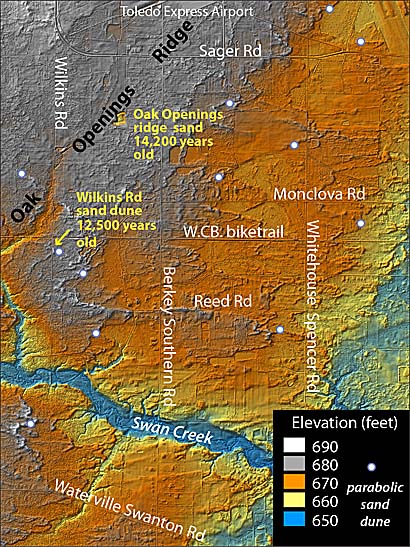Geological research of the northwest Ohio area conducted by an alumna of The University of Toledo and UT professors has been chosen as the Canadian Journal of Earth Sciences Editor’s Choice article for 2014.

This digital elevation model by Dr. Tim Fisher shows the Oak Openings Ridge (at grey elevations) formed initially as a spit of land built into glacial Lake Warren about 14,200 years ago. After Lake Warren drained, wind from the west reworked much of the sand into thousands of parabolic-shaped sand dunes that migrated onto the flat lake plain east of the spit, according to the UT professor. Only a few of the dunes are indicated by the white circles. The Wilkins Road dune just south of the bike trail was found to be 12,500 years old. Other sand dunes in the area range between 13,000 and 8,200 years old. The distribution of the flora and fauna in the Oak Openings region, much of it on state endangered lists, has adapted to this unique sandy environment.
Conducting the research were Melinda Higley, UT alumna and doctoral student at the University of Illinois at Urbana-Champaign; Dr. Tim Fisher, UT professor of geology and associate editor of the Canadian Journal of Earth Sciences; Dr. Harry Jol, professor of geography and anthropology at the University of Wisconsin-Eau Claire; Dr. Kenneth Lepper, associate professor of geology at North Dakota State University; and Dr. James Martin-Hayden, UT associate professor of geology.
“Melinda was curious to know how much sand was in the Oak Openings region and wanted to get a better idea about what the depositional environment was for the large sand ridge,” Fisher said.
The results of the study indicated that the Oak Openings Region is a spit, a landform developed along a shoreline where sand builds a ridge out into deeper water.
“The research filled in a lot of information about something not known much about. In general, we knew what happened in the past, but we didn’t have any specific details,” Fisher said. “Melinda collected 4.4 line kilometers of ground-penetrating radar data, which is a lot of work, as part of a master’s thesis; so we had quite a broad dataset to work with. We also used a variety of other techniques, which added strength to the interpretations in our conclusion. It’s a fairly detailed and thorough study of an important landscape in northwest Ohio.”
Researchers also gained an understanding about the various layers of sand the area contains, the thickness of the sand, and the depositional environment such as off-shore sand, beach sand, and sand blown up into dunes.
“We have a better idea about how old the area is,” Fisher said.
The researchers used a technique called optically stimulated luminescence dating to determine that the Oak Opening ridge formed about 14,000 years ago, and the sand dunes adjacent and overtop it formed between 13,000 and 8,000 years ago.
“That’s the goal of what we do in geology. Most of the events we study are in the past, but part of what we are trying to do is reconstruct the past to understand the present and be able to predict the future.”
The Editor’s Choice award recognizes articles of particularly high-quality and topical importance.
“It’s an international journal so you’re being recognized by the editor of an international journal, which tells you that you’re doing high-quality research,” Fisher said. “The department, faculty and students are being recognized internationally for the work they are doing, so that should raise the prestige of the department, college and University. We want to have a high-quality program, and this is evidence that we’re growing and moving in the right direction.”
The journal’s editor-in-chief also granted Internet users permanent, open access to the article, a privilege given to a few, select articles each year.
“Looking at a landscape is sort of like looking at a painting; it’s a bunch of colors and shapes. But if you know more about the artist, the artist’s background, and what’s going on at the time, with that information you suddenly appreciate that painting a lot more. It’s the same with geologic landscapes. You look at it and it’s pretty, but if you recognize the different elements of it and understand what the story is behind it, you’ll have a better appreciation for it.”
To read the research conducted on the Oak Openings region, click here.